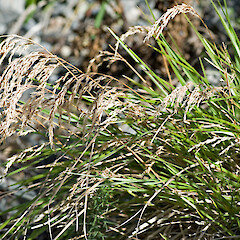Poa anceps
Common name
broad-leaved poa
Synonyms
Poa anceps G.Forst. var. anceps; Poa anceps var. elata Hook.f.; Poa anceps var. foliosa Hook.f.; Poa anceps var. densiflora Hook.f.; Poa anceps var. condensata Cheeseman; Poa affinis var. multiflora Hook.f.; Poa affinis var. agrostoidea Hook.f., Poa anceps G.Forst. subsp. anceps
Family
Poaceae
Flora category
Vascular – Native
Endemic taxon
Yes
Endemic genus
No
Endemic family
No
Structural class
Grasses
NVS code
The National Vegetation Survey (NVS) Databank is a physical archive and electronic databank containing records of over 94,000 vegetation survey plots - including data from over 19,000 permanent plots. NVS maintains a standard set of species code abbreviations that correspond to standard scientific plant names from the Ngä Tipu o Aotearoa - New Zealand Plants database.
POAANC
Chromosome number
2n = 28
Current conservation status
The conservation status of all known New Zealand vascular plant taxa at the rank of species and below were reassessed in 2017 using the New Zealand Threat Classification System (NZTCS) – more information about this can be found on the NZTCS website. This report includes a statistical summary and brief notes on changes since 2012 and replaces all previous NZTCS lists for vascular plants.
Please note, threat classifications are often suggested by authors when publications fall between NZTCS assessment periods – an interim threat classification status has not been assessed by the NZTCS panel.
- Conservation status of New Zealand indigenous vascular plants, 2017 . 2018. Peter J. de Lange, Jeremy R. Rolfe, John W. Barkla, Shannel P. Courtney, Paul D. Champion, Leon R. Perrie, Sarah M. Beadel, Kerry A. Ford, Ilse Breitwieser, Ines Schönberger, Rowan Hindmarsh-Walls, Peter B. Heenan and Kate Ladley. Department of Conservation. Source: NZTCS and licensed by DOC for reuse under the Creative Commons Attribution 4.0 International licence.
2017 | Not Threatened
Previous conservation statuses
2012 | Not Threatened
2009 | Not Threatened
2004 | Not Threatened
Distribution
Endemic. New Zealand: Three Kings, North and South Islands (north and western coasts as far south as George Sound, on Banks Peninsula in the east).
Habitat
Coastal, lowland to subalpine. On coastal and inland cliffs, on rock falls, in open forest, scrub and grassland.
Wetland plant indicator status rating
Information derived from the revised national wetland plant list prepared to assist councils in delineating and monitoring wetlands (Clarkson et al., 2021 Manaaki Whenua – Landcare Research Contract Report LC3975 for Hawke’s Bay Regional Council). The national plant list categorises plants by the extent to which they are found in wetlands and not ‘drylands’. The indicator status ratings are OBL (obligate wetland), FACW (facultative wetland), FAC (facultative), FACU (facultative upland), and UPL (obligate upland). If you have suggestions for the Wetland Indicator Status Rating, please contact: [Enable JavaScript to view protected content]
FACU: Facultative Upland
Occasionally is a hydrophyte but usually occurs in uplands (non-wetlands).
Detailed description
Very variable, coarse, light green, greenish brown to bluish green perennial tufted grass to 1 m, with stiff erect leaves < stems, or often scrambling and trailing to 2 m, with hanging leaves and stems drooping from thick stolons, rooting at nodes below tufts; branching extravaginal, with up to three, short, glabrous, obtuse, bract-like sheaths at base; leaf-blades persistent. Leaf-sheath light green to light brown, coriaceous, folded and strongly keeled, lateral ribs conspicuous, smooth or slightly scabrid above, rarely minutely scabrid throughout. Ligule 0.5 mm, a truncate usually long-ciliate rim, scabrid abaxially. Leaf-blade coriaceous, folded–flat, 100–400 × 1.0–6.5 mm, abaxially with prominent, thickened midrib, and numerous, distinct lateral ribs, smooth apart from prickle-teeth near tip; upper surface smooth, or scabrid on ribs, rarely papillose-scabrid, occasionally with fringe of stiff short hairs above ligule; margins smooth or scabrid, thickened, tip acuminate or abruptly acute, often pungent, scabrid. Culm 150–700 mm, often not far exserted beyond uppermost leaf-sheath, internodes glabrous. Panicle 100–280 mm, usually open with numerous spreading branches, sometimes contracted, branches whorled, very slender; rachis and primary branches often smooth, secondary branchlets finely, sharply, densely or sparsely scabrid or smooth, often spikelet-bearing ± throughout. Spikelets numerous, 3.0–7.5 mm, 2–8-flowered light green. Glumes subequal, narrow- to elliptic-lanceolate, acute to subobtuse, occasionally smooth throughout, or upper ⅔ scabrid; lower slightly shorter, lower glume 2.0–4.5 mm, 3-nerved, upper 2.5–5.0 mm, 3-nerved. Lemma 3.0–4.5 mm, 5–7-nerved, elliptic-oblong, acute to subobtuse, internerves finely scaberulous throughout, occasionally only minutely papillose, bearing short crinkled hairs on lower ½ of midnerve and near base of outer lateral nerves; margins minutely scabrid. Palea 2.5–4.0 mm, keels finely scabrid, interkeel and flanks smooth or minutely scabrid. Callus with thick tuft of soft crinkled hairs. Rachilla c. 0.5 mm, smooth or minutely, sparsely scabrid; prolongation c. twice as long. Lodicules c. 0.5 mm, occasionally hair-tipped. Anthers 1.5–2.5 mm. Seed c. 2.0 × 0.5 mm.
Manaaki Whenua Online Interactive Key
Similar taxa
The Kermadec Islands Poa polyphylla Hack. is closely related (see under that species). Poa anceps is most likely to be confused with Poa xenica (see under that species) and Poa chathamica (see under that species). However, as these species grow in habitats where Poa anceps is not found confusion in the field is unlikely.
Flowering
September–December
Fruiting
November–May
Propagation technique
Easily grown from fresh seed and rooted pieces. An excellent grass that deserves to be more widely cultivated. Poa anceps is a very variable species and would repay some critical horticultural selection. It is best grown in full sun, and is excellent on banks where it can trail down slope. This species is tolerant of a wide range of conditions.
Etymology
poa: Meadow grass
anceps: From the Latin an- ‘two’ and caputus ‘head’, meaning two-faced or two-edged
Attribution
Fact sheet prepared for NZPCN by P.J. de Lange (June 2005). Description modified from Edgar and Connor (2000).
References and further reading
Edgar E, Connor HE. 2000. Flora of New Zealand. Vol. V. Grasses. Manaaki Whenua Press, Christchurch, NZ. 650 p.















